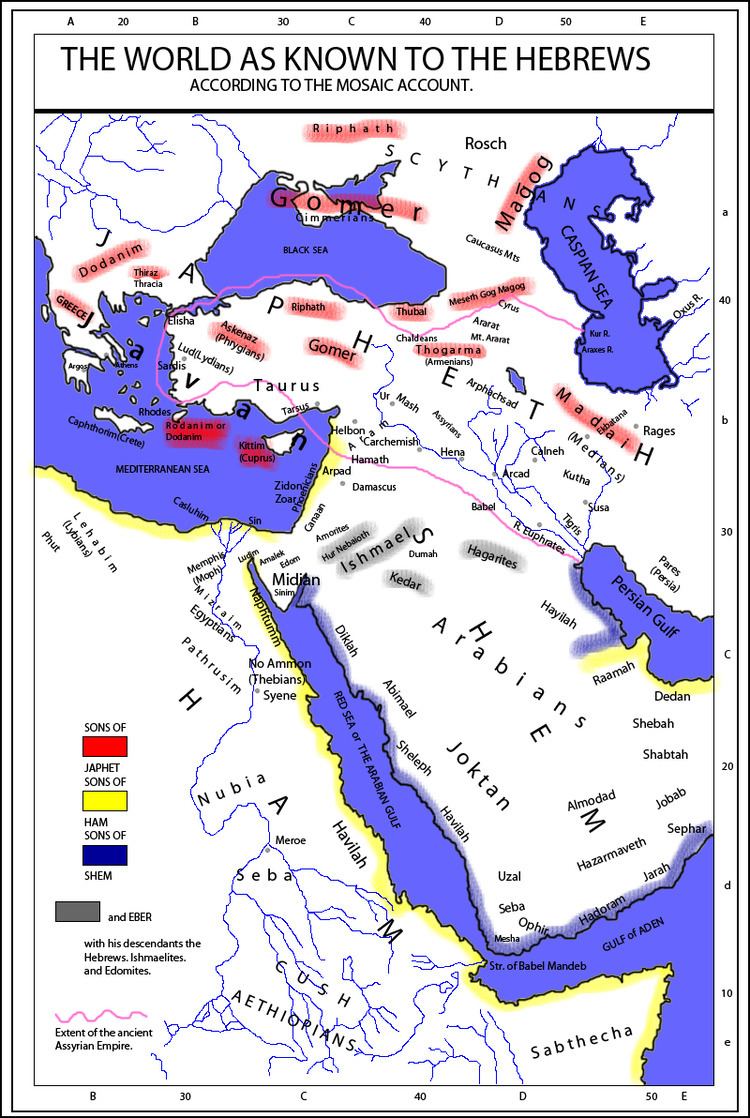 | ||
Caphtor (Hebrew: כפתור) is a locality mentioned in the Bible, in which its people are called Caphtorites (or Caphtorim) and are named as a division of the ancient Egyptians. Caphtor is also mentioned in ancient inscriptions from Egypt, Mari, and Ugarit. Traditional sources placed Caphtor in the region of Pelusium, though modern sources tend to associate it with localities such as Cilicia, Cyprus, or Crete.
Contents
Traditional accounts
The Caphtorites are mentioned in the Table of Nations, Genesis 10:13-14 as one of several divisions of Mizraim (Egypt). This is reiterated in 1Chronicles 1:11-12 as well as later histories such as Josephus' Jewish Antiquities i.vi.2, which placed them explicitly in Egypt and the Sefer haYashar 10 which describes them living by the Nile.
Josephus (Jewish Antiquities I, vi) using extra-Biblical accounts provides context for the migration from Caphtor to Philistia. He records that the Caphtorites were one of the Egyptian peoples whose cities were destroyed during the Ethiopic War.
Tradition regarding the location of Caphtor was preserved in the Aramaic Targums and the commentary of Maimonides which place it at Caphutkia in the vicinity of Damietta (at the eastern edge of the Nile delta near classical Pelusium) and by the tenth century commentator Saadia Gaon and Benjamin of Tudela, the twelfth-century Jewish traveller from Navarre, who both wrote that Damietta was Caphtor.
The Midrash Rabbah on Genesis 37:5 (page 298 in the 1961 edition of Maurice Simon's translation) says that the "Caphtorim were dwarfs". However Goliath, is a giant Philistine warrior.
Translation
The Targums translate Caphtor into Aramaic as Kaputkai, Kapudka or similar i.e. Caphutkia explained by Maimonides as being Damietta.
Referencing Katpatuka, the Septuagint translated the name as "Kappadokias" and the Vulgate similarly renders it as "Cappadocia". The seventeenth-century scholar Samuel Bochart understood this as a reference to Cappadocia in Anatolia but John Gill noted that these translations relate to Caphutkia.
Etymology and interpretation
The name Caphtor is identical to the Biblical Hebrew word for a knob-like structure.
Modern identifications
From the 18th century onwards commentators attempted several identifications of Caphtor which increasingly disregarded the traditional identification as an Egyptian coastal locality in the vicinity of Pelusium. These included identification with Coptus, Colchis, Cyprus, Cappadocia in Asia Minor, Cilicia, and Crete.
The identification with Coptus is noted in Osborne's A Universal History From The Earliest Account of Time, where it is remarked that many suppose the name to have originated from Caphtor. While this interepretation agrees with tradition placing Caphtor in Egypt it disregards the tradition that it was a coastland (iy rendered island in some Bible translations) and more precisely Caphutkia and this contradiction is noted in Osborne. It is now known that the name Coptus is derived from Egyptian Gebtu which is not associated with the name Caphtor.
Egyptian kftı͗w (conventionally vocalized as Keftiu) is attested in numerous inscriptions. The 19th-century belief that Keftiu/Caphtor was to be identified with Cyprus or Syria shifted to an association with Crete under the influence of Sir Arthur Evans. It was criticized in 1931 by G. A. Wainwright, who located Keftiu in Cilicia, on the Mediterranean shore of Asia Minor, and he drew together evidence from a wide variety of sources: in geographical lists and the inscription of Tutmose III's "Hymn of Victory", where the place of Keftiu in lists appeared to exist among recognizable regions in the northeasternmost corner of the Mediterranean, in the text of the "Keftiuan spell" śntkppwymntrkkr, of ca 1200 BCE, in which the Cilician and Syrian deities Tarku (the Hittite sun god), Sandan (the cilician and lydian equivalent of Tarku), and Kubaba were claimed, in personal names associated in texts with Keftiu and in Tutmose's "silver shawabty vessel of the work of Keftiu" and vessels of iron, which were received as gifts from Tinay in northern Syria. Wainwright's theory is not widely accepted, as his evidence shows at most a cultural exchange between Keftiu and Anatolia without pinpointing its location on the Mediterranean coast. In 1980 J. Strange drew together a comprehensive collection of documents that mentioned Caphtor or Keftiu. He noted that crucial texts dissociate Keftiu from "the islands in the middle of the sea", by which Egyptian scribes denoted Crete.
The stone base of a statue during the reign of Amenhotep III includes the name kftı͗w in a list of Mediterranean ship stops prior to several Cretan cities such as Kydonia, Phaistos, and Amnisos, perhaps showing that the term may not refer to Crete.
